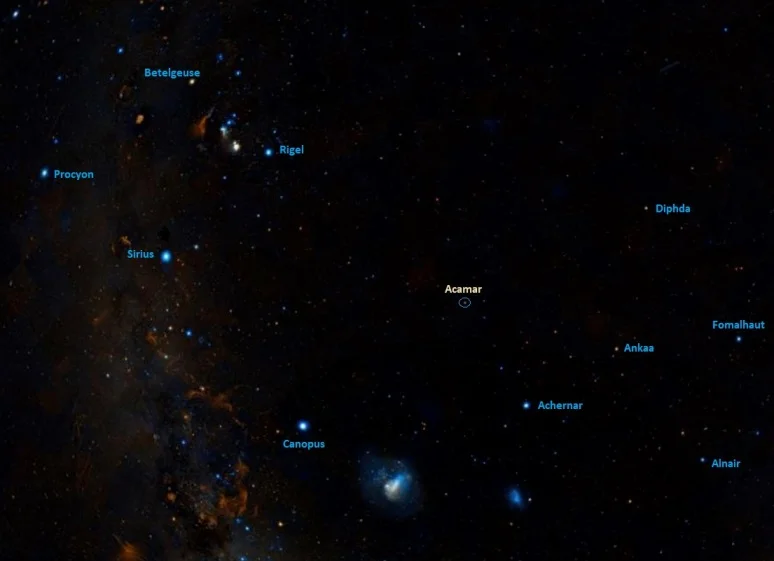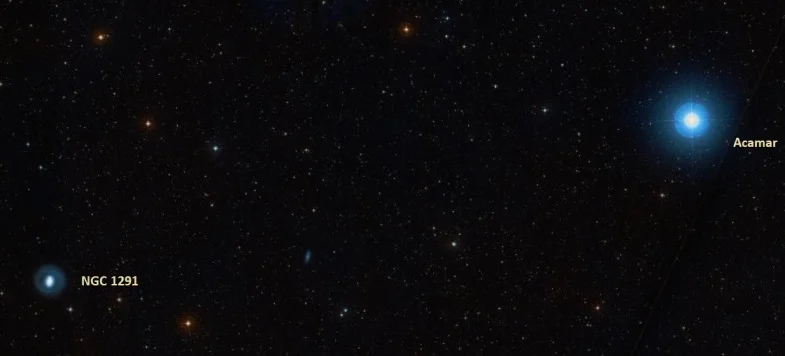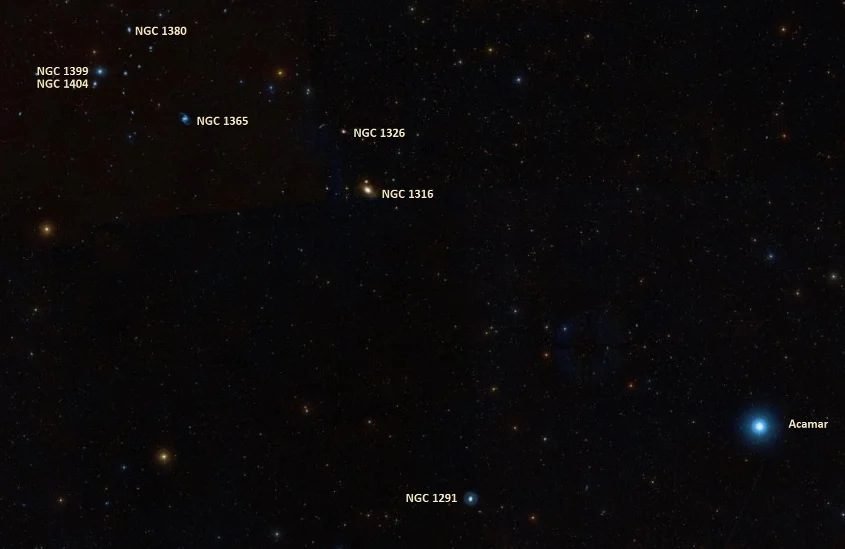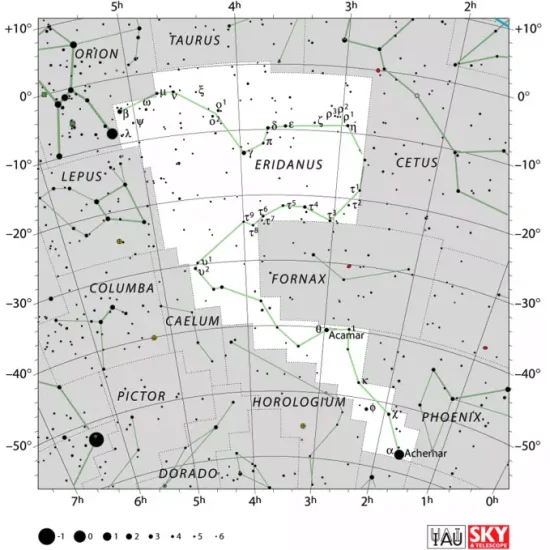Acamar, Theta Eridani (θ Eri), is a binary star system consisting of two white class A stars located in the constellation Eridanus. The system has an apparent magnitude of 2.91 and lies at a distance of 161 light years from Earth. It is the third brightest point of light in Eridanus, after Achernar and Cursa. Acamar once marked the end of the celestial river represented by Eridanus, before the brighter Achernar was added to the constellation.
Star system
The Theta Eridani system consists of two components, Theta1 Eridani and Theta2 Eridani. The system has a combined visual magnitude of 2.91. The two components are separated by 8.3 arcseconds on the sky. Individually, the components have apparent magnitudes of 3.195 (Theta1) and 4.119 (Theta2). Theta1 may itself be a spectroscopic binary.
The brighter component, Theta1 Eridani, is formally known as Acamar. The star has the spectral classification A3IV-V, indicating a white star that is coming to an end of its main sequence lifetime. Acamar has a mass of 2.6 solar masses and a radius 16 times that of the Sun. With an effective temperature of 8,200 K, it shines with 145 solar luminosities. With a projected rotational velocity of 70 km/s, the star takes 569 days to complete a rotation.

Acamar (Theta Eridani), image: Wikisky
The companion, Theta2 Eridani, is still on the main sequence. It is a white star of the spectral type A1V, hotter, less luminous and slightly less massive than the primary component. Theta2 Eridani has a mass 2.4 times that of the Sun and, with a surface temperature of 9,200 K, it is 36 times more luminous than the Sun. The star has a projected rotational velocity of 90 km/s.
Facts
Acamar and the brighter Achernar are among the 58 stars that have a special status in the field of celestial navigation. They are the only navigational stars in Eridanus. The two stars belong to a group of 18 navigational stars of the southern hemisphere with a declination between 30° S and 90° S. Other stars in this group are Kaus Australis in the constellation Sagittarius, Shaula in Scorpius, Canopus, Avior and Miaplacidus in Carina, Acrux and Gacrux in Crux, Rigil Kentaurus, Hadar and Menkent in Centaurus, Alnair in Grus, Peacock in Pavo, Suhail in Vela, Fomalhaut in Piscis Austrinus, Ankaa in Phoenix, and Atria in Triangulum Australe.
The binary nature of Theta Eridani was discovered by the Italian astronomer Giuseppe Piazzi (1746-1826). In his Praecipuarum stellarum inerrantium positiones mediae of 1814, Piazzi gave apparent magnitudes of 4.5 and 5.6 for the two components.
The Greek astronomer Claudius Ptolemy described Acamar as a first-magnitude star in the 2nd century CE. Some believe that he was in fact describing Achernar, the brightest star in Eridanus and the 9th brightest star in the sky. However, back then, Achernar was not visible from Alexandria, from where Ptolemy made his observations. Today the star can be seen low above the southern horizon from Alexandria due to the Earth’s axial precession. In Ptolemy’s time, the constellation Eridanus (one of the 48 Greek constellations, listed by Ptolemy in his Almagest) ended at Acamar. While the astronomer may have indeed heard of Achernar and mentioned it, it is also possible that Acamar was a first-magnitude star in ancient times.
Name
The name Acamar (pronunciation: /ˈækəmɑːr/) has the same etymology as Achernar. Both names are derived from the Arabic Ākhir an-nahr, meaning “the end of the river.” Originally, the constellation Eridanus extended only to Acamar, since Achernar was not visible from Europe. Achernar was only added to Eridanus in the 18th century. The term Ākhir an-nahr was used by Egyptian astronomer Al Achsasi al Mouakket in his Calendarium, written around 1650. It was later translated into Latin as Postrema Fluminis, also meaning “the end of the river.”
The name Acamar was approved by the International Astronomical Union’s (IAU) Working Group on Star Names (WGSN) on July 20, 2016. It formally applies only to the component Theta1 Eridani.
The Chinese know Acamar as 天園六 (Tiān Yuán liù), the Sixth Star of Celestial Orchard. The Chinese Celestial Orchard asterism is formed by Acamar with Delta Phoenicis, Chi Eridani, Phi Eridani, Kappa Eridani, s Eridani (HD 16754), h Eridani (HD 23319), f Eridani (HD 24072), g Eridani (HD 24160), Upsilon4 Eridani, Beemim (Upsilon³ Eridani), Theemin (Upsilon2 Eridani), and Upsilon1 Eridani. The asterism is part of the Net mansion, which represents the body of the White Tiger.
Location
Acamar is not too difficult to find. Located in the region of the sky between the bright Sirius in the constellation Canis Major and Fomalhaut in Piscis Austrinus, Acamar is the brightest in a triangle of stars also formed by Iota Eridani (mag. 4.11) and s Eridani (HD 16754, mag. 4.74). The triangle lies on an imaginary line extended from Betelgeuse through Rigel, the brightest stars in the distinctive hourglass figure of Orion.

Acamar location, image: Wikisky
Acamar can be used to find several deep sky objects that lie in the same area. The ring galaxy NGC 1291 (mag. 9.39) appears just east of the star. It lies 33 million light years away.

Acamar and NGC 1291, image: Wikisky
The Fornax Cluster of galaxies can be seen northeast of Acamar. The cluster lies 62 million light years away in the constellation Fornax. The brightest members include NGC 1399 (mag. 9.9), a large elliptical galaxy at the centre of the cluster, the elliptical galaxy NGC 1404 (mag. 10.3), the double-barred spiral galaxy NGC 1365 (mag. 10.3), nicknamed the Great Barred Spiral Galaxy, and the lenticular galaxies NGC 1316 (mag. 9.4), also known as Fornax A, NGC 1326 (mag. 10.54), and NGC 1380 (mag. 9.9).

Acamar, NGC 1316, NGC 1291, NGC 1326, NGC 1365, NGC 1380, NGC 1386, NGC 1399, and NGC 1404, image: Wikisky
Constellation
Acamar is located in the constellation Eridanus. Representing a river, Eridanus is the sixth largest constellation in the sky, occupying an area of 1,138 square degrees. It stretches from Cursa (Beta Eridani) at the foot of Orion (marked by Rigel) all the way to Achernar in the far southern sky.

Eridanus constellation map by IAU and Sky&Telescope magazine
Eridanus is best known for being home to Achernar, the ninth brightest star in the sky, and Epsilon Eridani (formally named Ran), the third nearest visible star (system) to the Sun, after Alpha Centauri and Sirius. Located only 10.475 light years away, the star is known to host at least one exoplanet.
Interesting deep sky objects in Eridanus include the Witch Head Nebula (IC 2118), a reflection nebula illuminated by Rigel, the planetary nebula known as Cleopatra’s Eye Nebula (NGC 1535), the ring galaxy NGC 1291 near Acamar, and the spiral galaxies NGC 1232 and NGC 1300 near Angetenar (Tau2 Eridani), both members of the Eridanus Cluster of galaxies.
The best time of year to observe the stars and deep sky objects in Eridanus is during the month of December, when the constellation rises high in the evening sky. The entire constellation is visible from locations between the latitudes 32° N and 90° S.
The 10 brightest stars in Eridanus are Achernar (Alpha Eri, mag. 0.40 – 0.46), Cursa (Beta Eri, mag. 2.796), Acamar (Theta1 Eri, mag. 2.91), Zaurak (Gamma Eri, mag. 2.88 – 2.96), Rana (Delta Eri, mag. 3.51 – 3.56), Upsilon4 Eridani (mag. 3.55), Phi Eridani (mag. 3.55), Chi Eridani (3.70), Tau4 Eridani (mag. 3.57 – 3.72), and Ran (Epsilon Eri, mag. 3.736).
Acamar – Theta Eridani
| Spectral class | A3IV-V |
| Variable type | Suspected |
| U-B colour index | 0.14 |
| B-V colour index | 0.14 |
| Apparent magnitude | 2.91 |
| Absolute magnitude | -0.59 |
| Distance | 161 ± 4 light years (49 ± 1 parsecs) |
| Parallax | 20.23 ± 0.55 mas |
| Radial velocity | 11.9 km/s |
| Proper motion | RA: −52.89 mas/yr |
| Dec.: +21.98 mas/yr | |
| Constellation | Eridanus |
| Right ascension | 02h 58m 15.67525s |
| Declination | −40° 18′ 16.8524″ |
| Names and designations | Theta Eridani, θ Eri, HIP 13847, SAO 216113, CD-40° 771, CCDM J02583-4018, WDS 02583-4018 |
Theta1 Eridani
| Spectral type | A3IV-V |
| Apparent magnitude | 3.195 |
| Parallax | 19.5598 ± 0.3494 mas |
| Radial velocity | 11.9 km/s |
| Proper motion | RA: -54.461 ± 0.550 mas/yr |
| Dec.: 23.503 ± 0.588 mas/yr | |
| Mass | 2.6 M☉ |
| Luminosity | 145 L☉ |
| Radius | 16.0 R☉ |
| Temperature | 8,200 K |
| Rotational velocity | 70 km/s |
| Rotation | 569 days |
| Right ascension | 02h 58m 15.6792190187s |
| Declination | -40° 18′ 16.845665573” |
| Names and designations | Acamar, Theta1 Eridani, θ1 Eri, HD 18622, HR 897, SAO 216113, FK5 106, PPM 307195, GC 3584, GCRV 1661, CCDM J02583-4018A, CD-40 771A, CPC 0 1403, CPD-40 253A, IDS 02545-4042 A, PLX 624.00A, WDS J02583-4018A, TYC 7563-1016-1, Gaia DR2 5044368071869592832 |
Theta2 Eridani
| Spectral type | A1V |
| Apparent magnitude | 4.119 |
| Parallax | 20.3349 ± 0.2227 mas |
| Radial velocity | 18.8 km/s |
| Proper motion | RA: -51.661 ± 0.364 mas/yr |
| Dec.: 16.178 ± 0.384 mas/yr | |
| Mass | 2.4 M☉ |
| Luminosity | 36 L☉ |
| Temperature | 9,200 K |
| Rotational velocity | 90 km/s |
| Right ascension | 02h 58m 16.4053309356s |
| Declination | -40° 18′ 16.900014010” |
| Names and designations | Theta2 Eridani, θ2 Eri, HD 18623, HR 898, SAO 216114, PPM 307196, GC 3586, GCRV 1662, CCDM J02583-4018B, CD-40 771B, CPD-40 253B, IDS 02545-4042 B, PLX 624.00B, WDS J02583-4018B, TYC 7563-1017-1, Gaia DR2 5044368071868204160 |